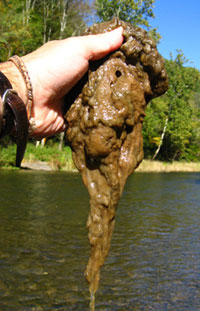INVASIVE SPECIES INFORMATION
 Photo - Tim Daley, PA DEP |
Didymo
What is Didymo?
Didymosphenia geminata, also known as 'rock snot' or 'didymo', is a microscopic alga known as a diatom that's invading our rivers and streams. It can smother entire stream beds with mats as thick as eight inches and can ruin just about any river or creek. Once in a stream, there is no known way to remove it. All that can be done is to try to prevent its spread. The spores will stick to anything (boots, waders, fishing line, boats, etc.) that goes into the infected water and in a damp environment they can live for days. The only thing to do is clean and disinfect everything. The following is from the EPA but please also check MD DNR for more detailed information. Please note that you have to be very careful with chlorine bleach; even in tiny amounts, it is toxic to fish. Be sure to use it sufficiently far from the stream so that there is no chance of any getting into the stream and be sure to rinse well anything on which it is used.
CHECK:
Before leaving a river's edge, look for clumps of algae and sediment, and remove them. Leave them at the site.
CLEAN:
Soak all gear for at least one minute in a 2% (by volume) solution of household bleach, or a 5% (by volume) solution of dishwashing detergent or salt. All surfaces must be in contact with the cleaning solution for a full minute. Water-absorbent equipment (lifejackets, waders) should be soaked thoroughly to ensure complete contact.
DRY:
If cleaning is not practical, after the item is dry to the touch, leave it to dry for at least another 48 hours before using in another freshwater system.
Whirling Disease
What is Whirling Disease?
Myxobolus cerebralis (Mc) is a parasite that infiltrates the head and spinal cartilage of fingerling trout where it multiplies rapidly, putting pressure on the organ of equilibrium. This causes the fish to swim erratically (whirl), and have difficulty feeding and avoiding predators, in severe cases, die. In severe infections, the disease can cause high rates of mortality in young-of-the-year fish. When an infected fish dies, millions of tiny indestructible Mc spores (each about the size of a red blood cell) are released to the water where they can survive in this "dormant" form for up to 30 years.
Therein lies the gravity of the whirling disease problem. M. cerebralis is virtually indestructible -- the spore can withstand freezing and desiccation, and can survive in a stream for 20 to 30 years. Whirling disease is most infective to rainbow and cutthroat trout, but can infect all salmonid species, including brook trout. For more information, please reference the Maryland DNR Whirling Disease page.
 |
Felt Soles Banned
Felt Soles have been banned in Maryland waters as of March 22, 2011. Resource managers in North America and New Zealand suspected early on that the felt-soled waders and boots of traveling fly fishermen were the pathway for its spread. Subsequent field and laboratory research has confirmed that the felt used for waders is an ideal medium for collecting and transporting microscopic organisms. DNR scientists and anglers have found seasonal infestations of Didymo in the Gunpowder River and traces of the organism in the Savage River. Other diseases and injurious species such as Whirling Disease, which is fatal to trout, may be carried on felt soles. Felt has been banned from New Zealand streams since 2008. Several other states have also banned felt soles. A number of companies now offer resoling services. This is often less expensive than purchasing new boots or waders. You can do a google search to find such companies.